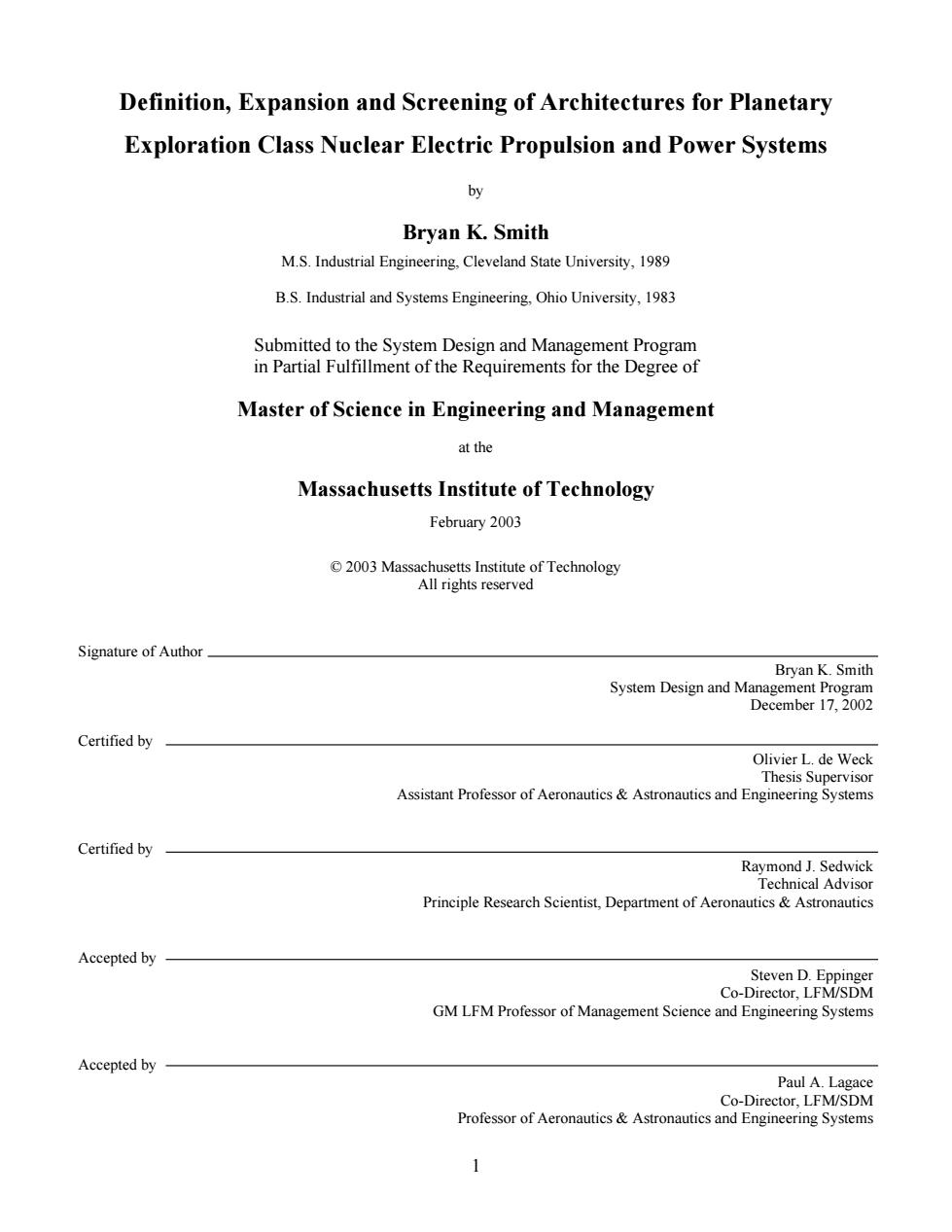
Definition,Expansion and Screening of Architectures for Planetary Exploration Class Nuclear Electric Propulsion and Power Systems by Bryan K.Smith M.S.Industrial Engineering,Cleveland State University,1989 B.S.Industrial and Systems Engineering,Ohio University,1983 Submitted to the System Design and Management Program in Partial Fulfillment of the Requirements for the Degree of Master of Science in Engineering and Management at the Massachusetts Institute of Technology February 2003 2003 Massachusetts Institute of Technology All rights reserved Signature of Author Bryan K.Smith System Design and Management Program December 17,2002 Certified by Olivier L.de Weck Thesis Supervisor Assistant Professor of Aeronautics Astronautics and Engineering Systems Certified by Raymond J.Sedwick Technical Advisor Principle Research Scientist,Department of Aeronautics Astronautics Accepted by Steven D.Eppinger Co-Director.LFM/SDM GM LFM Professor of Management Science and Engineering Systems Accepted by Paul A.Lagace Co-Director.LFM/SDM Professor of Aeronautics Astronautics and Engineering Systems
Definition, Expansion and Screening of Architectures for Planetary Exploration Class Nuclear Electric Propulsion and Power Systems by Bryan K. Smith M.S. Industrial Engineering, Cleveland State University, 1989 B.S. Industrial and Systems Engineering, Ohio University, 1983 Submitted to the System Design and Management Program in Partial Fulfillment of the Requirements for the Degree of Master of Science in Engineering and Management at the Massachusetts Institute of Technology February 2003 © 2003 Massachusetts Institute of Technology All rights reserved Signature of Author Bryan K. Smith System Design and Management Program December 17, 2002 Certified by Olivier L. de Weck Thesis Supervisor Assistant Professor of Aeronautics & Astronautics and Engineering Systems Certified by Raymond J. Sedwick Technical Advisor Principle Research Scientist, Department of Aeronautics & Astronautics Accepted by Steven D. Eppinger Co-Director, LFM/SDM GM LFM Professor of Management Science and Engineering Systems Accepted by Paul A. Lagace Co-Director, LFM/SDM Professor of Aeronautics & Astronautics and Engineering Systems 1
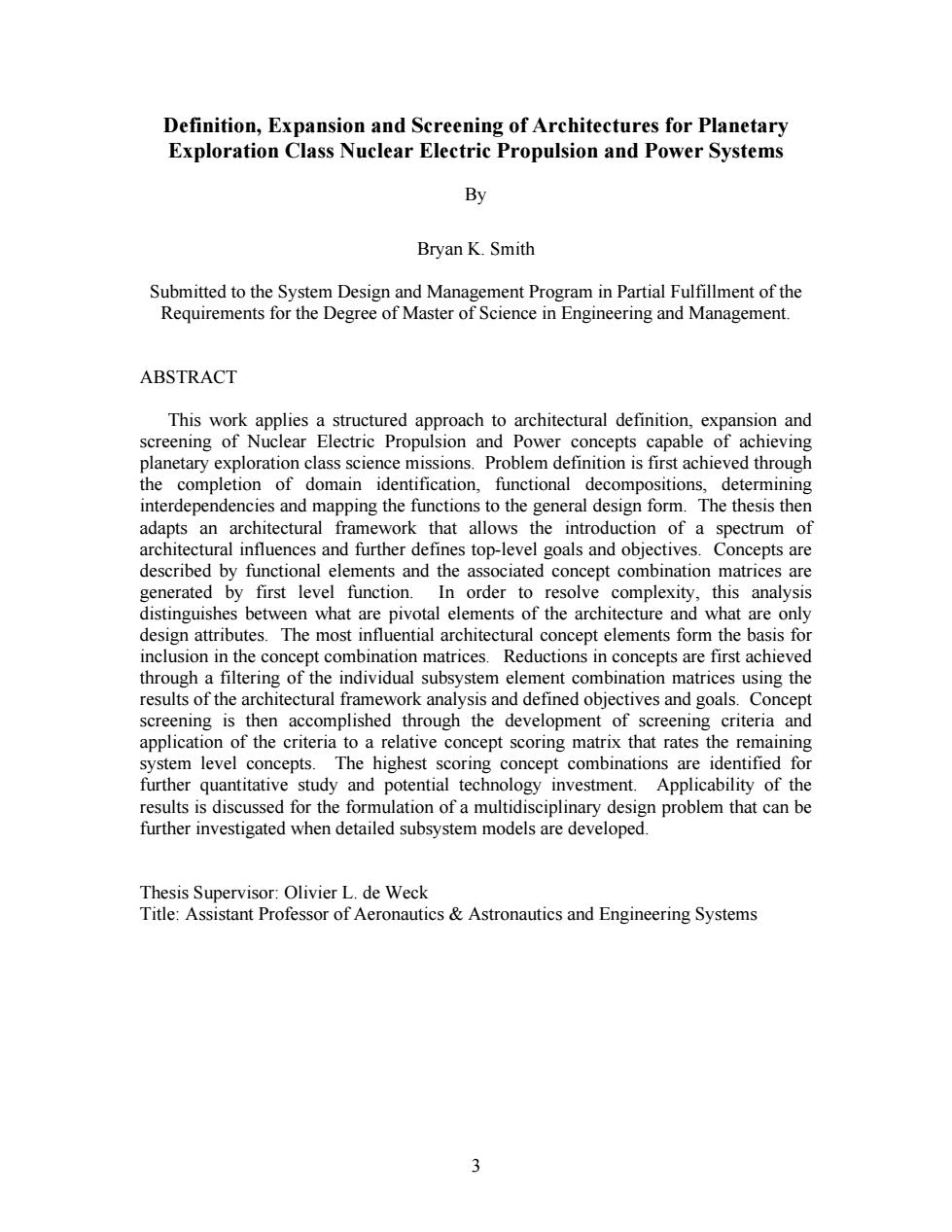
Definition,Expansion and Screening of Architectures for Planetary Exploration Class Nuclear Electric Propulsion and Power Systems By Bryan K.Smith Submitted to the System Design and Management Program in Partial Fulfillment of the Requirements for the Degree of Master of Science in Engineering and Management. ABSTRACT This work applies a structured approach to architectural definition,expansion and screening of Nuclear Electric Propulsion and Power concepts capable of achieving planetary exploration class science missions.Problem definition is first achieved through the completion of domain identification,functional decompositions,determining interdependencies and mapping the functions to the general design form.The thesis then adapts an architectural framework that allows the introduction of a spectrum of architectural influences and further defines top-level goals and objectives.Concepts are described by functional elements and the associated concept combination matrices are generated by first level function.In order to resolve complexity,this analysis distinguishes between what are pivotal elements of the architecture and what are only design attributes.The most influential architectural concept elements form the basis for inclusion in the concept combination matrices.Reductions in concepts are first achieved through a filtering of the individual subsystem element combination matrices using the results of the architectural framework analysis and defined objectives and goals.Concept screening is then accomplished through the development of screening criteria and application of the criteria to a relative concept scoring matrix that rates the remaining system level concepts.The highest scoring concept combinations are identified for further quantitative study and potential technology investment.Applicability of the results is discussed for the formulation of a multidisciplinary design problem that can be further investigated when detailed subsystem models are developed. Thesis Supervisor:Olivier L.de Weck Title:Assistant Professor of Aeronautics Astronautics and Engineering Systems 3
Definition, Expansion and Screening of Architectures for Planetary Exploration Class Nuclear Electric Propulsion and Power Systems By Bryan K. Smith Submitted to the System Design and Management Program in Partial Fulfillment of the Requirements for the Degree of Master of Science in Engineering and Management. ABSTRACT This work applies a structured approach to architectural definition, expansion and screening of Nuclear Electric Propulsion and Power concepts capable of achieving planetary exploration class science missions. Problem definition is first achieved through the completion of domain identification, functional decompositions, determining interdependencies and mapping the functions to the general design form. The thesis then adapts an architectural framework that allows the introduction of a spectrum of architectural influences and further defines top-level goals and objectives. Concepts are described by functional elements and the associated concept combination matrices are generated by first level function. In order to resolve complexity, this analysis distinguishes between what are pivotal elements of the architecture and what are only design attributes. The most influential architectural concept elements form the basis for inclusion in the concept combination matrices. Reductions in concepts are first achieved through a filtering of the individual subsystem element combination matrices using the results of the architectural framework analysis and defined objectives and goals. Concept screening is then accomplished through the development of screening criteria and application of the criteria to a relative concept scoring matrix that rates the remaining system level concepts. The highest scoring concept combinations are identified for further quantitative study and potential technology investment. Applicability of the results is discussed for the formulation of a multidisciplinary design problem that can be further investigated when detailed subsystem models are developed. Thesis Supervisor: Olivier L. de Weck Title: Assistant Professor of Aeronautics & Astronautics and Engineering Systems 3
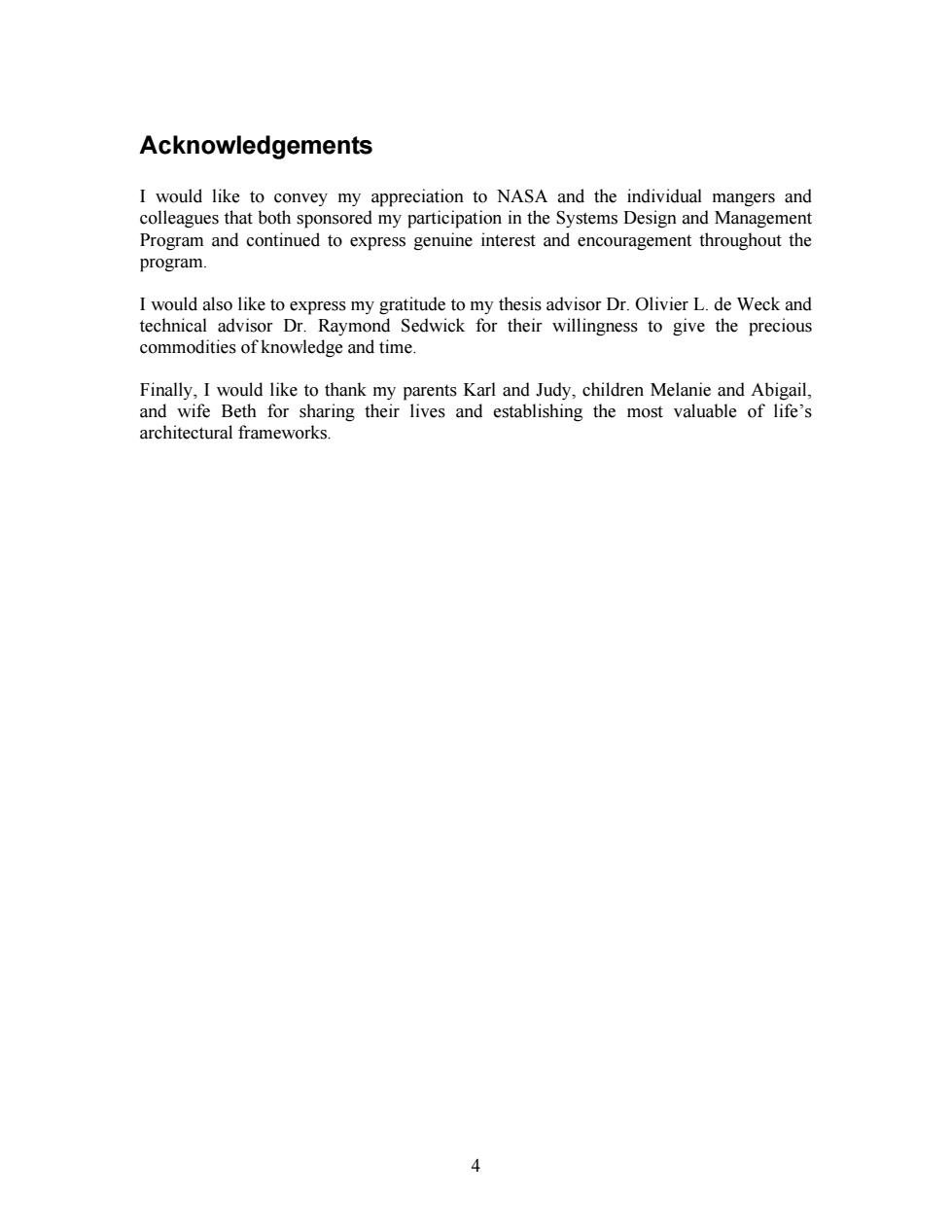
Acknowledgements I would like to convey my appreciation to NASA and the individual mangers and colleagues that both sponsored my participation in the Systems Design and Management Program and continued to express genuine interest and encouragement throughout the program I would also like to express my gratitude to my thesis advisor Dr.Olivier L.de Weck and technical advisor Dr.Raymond Sedwick for their willingness to give the precious commodities of knowledge and time. Finally,I would like to thank my parents Karl and Judy,children Melanie and Abigail, and wife Beth for sharing their lives and establishing the most valuable of life's architectural frameworks. 4
Acknowledgements I would like to convey my appreciation to NASA and the individual mangers and colleagues that both sponsored my participation in the Systems Design and Management Program and continued to express genuine interest and encouragement throughout the program. I would also like to express my gratitude to my thesis advisor Dr. Olivier L. de Weck and technical advisor Dr. Raymond Sedwick for their willingness to give the precious commodities of knowledge and time. Finally, I would like to thank my parents Karl and Judy, children Melanie and Abigail, and wife Beth for sharing their lives and establishing the most valuable of life’s architectural frameworks. 4
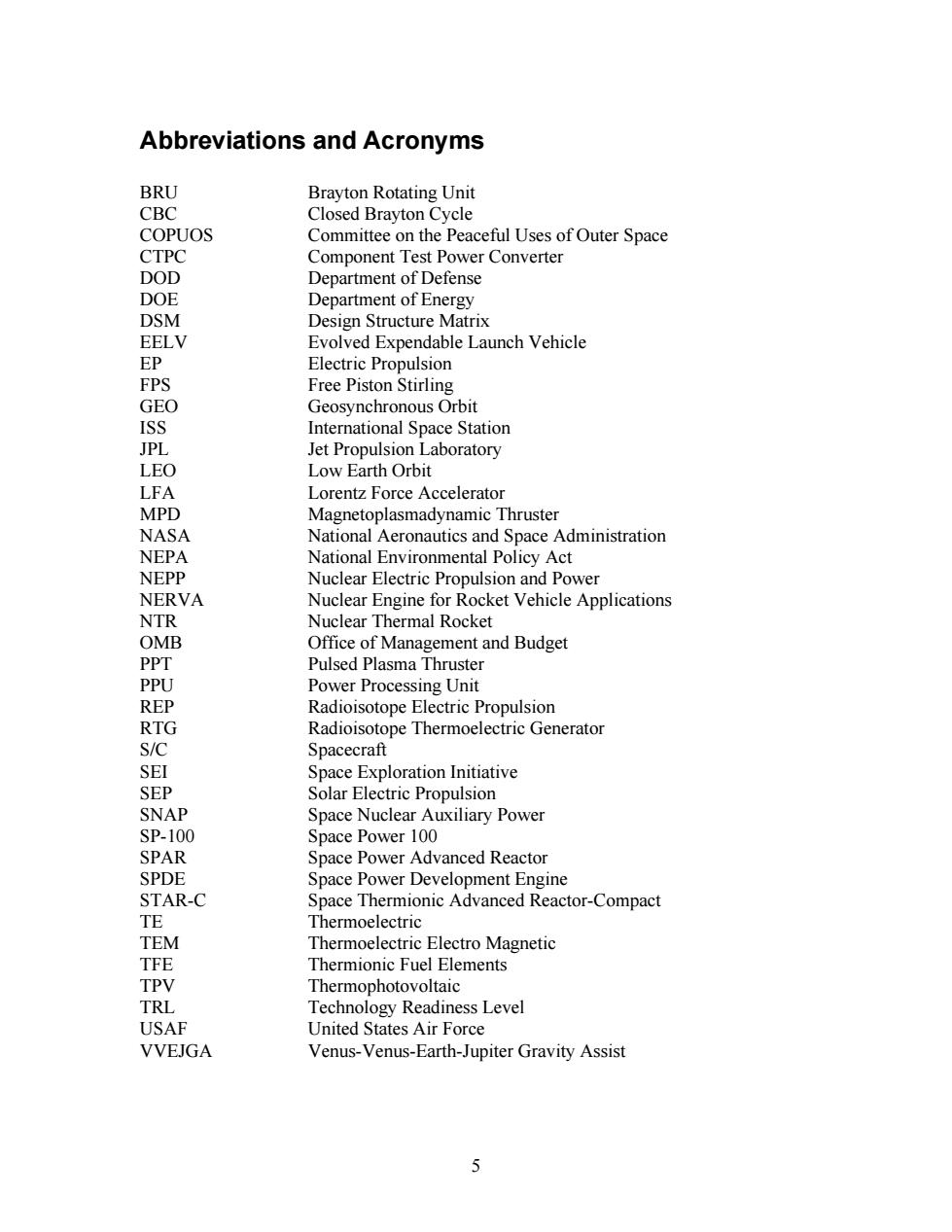
Abbreviations and Acronyms BRU Brayton Rotating Unit CBC Closed Brayton Cycle COPUOS Committee on the Peaceful Uses of Outer Space CTPC Component Test Power Converter DOD Department of Defense DOE Department of Energy DSM Design Structure Matrix EELV Evolved Expendable Launch Vehicle EP Electric Propulsion FPS Free Piston Stirling GEO Geosynchronous Orbit ISS International Space Station JPL Jet Propulsion Laboratory LEO Low Earth Orbit LFA Lorentz Force Accelerator MPD Magnetoplasmadynamic Thruster NASA National Aeronautics and Space Administration NEPA National Environmental Policy Act NEPP Nuclear Electric Propulsion and Power NERVA Nuclear Engine for Rocket Vehicle Applications NTR Nuclear Thermal Rocket OMB Office of Management and Budget PPT Pulsed Plasma Thruster PPU Power Processing Unit REP Radioisotope Electric Propulsion RTG Radioisotope Thermoelectric Generator S/C Spacecraft SEI Space Exploration Initiative SEP Solar Electric Propulsion SNAP Space Nuclear Auxiliary Power SP-100 Space Power 100 SPAR Space Power Advanced Reactor SPDE Space Power Development Engine STAR-C Space Thermionic Advanced Reactor-Compact TE Thermoelectric TEM Thermoelectric Electro Magnetic TFE Thermionic Fuel Elements TPV Thermophotovoltaic TRL Technology Readiness Level USAF United States Air Force VVEJGA Venus-Venus-Earth-Jupiter Gravity Assist 5
Abbreviations and Acronyms BRU Brayton Rotating Unit CBC Closed Brayton Cycle COPUOS Committee on the Peaceful Uses of Outer Space CTPC Component Test Power Converter DOD Department of Defense DOE Department of Energy DSM Design Structure Matrix EELV Evolved Expendable Launch Vehicle EP Electric Propulsion FPS Free Piston Stirling GEO Geosynchronous Orbit ISS International Space Station JPL Jet Propulsion Laboratory LEO Low Earth Orbit LFA Lorentz Force Accelerator MPD Magnetoplasmadynamic Thruster NASA National Aeronautics and Space Administration NEPA National Environmental Policy Act NEPP Nuclear Electric Propulsion and Power NERVA Nuclear Engine for Rocket Vehicle Applications NTR Nuclear Thermal Rocket OMB Office of Management and Budget PPT Pulsed Plasma Thruster PPU Power Processing Unit REP Radioisotope Electric Propulsion RTG Radioisotope Thermoelectric Generator S/C Spacecraft SEI Space Exploration Initiative SEP Solar Electric Propulsion SNAP Space Nuclear Auxiliary Power SP-100 Space Power 100 SPAR Space Power Advanced Reactor SPDE Space Power Development Engine STAR-C Space Thermionic Advanced Reactor-Compact TE Thermoelectric TEM Thermoelectric Electro Magnetic TFE Thermionic Fuel Elements TPV Thermophotovoltaic TRL Technology Readiness Level USAF United States Air Force VVEJGA Venus-Venus-Earth-Jupiter Gravity Assist 5
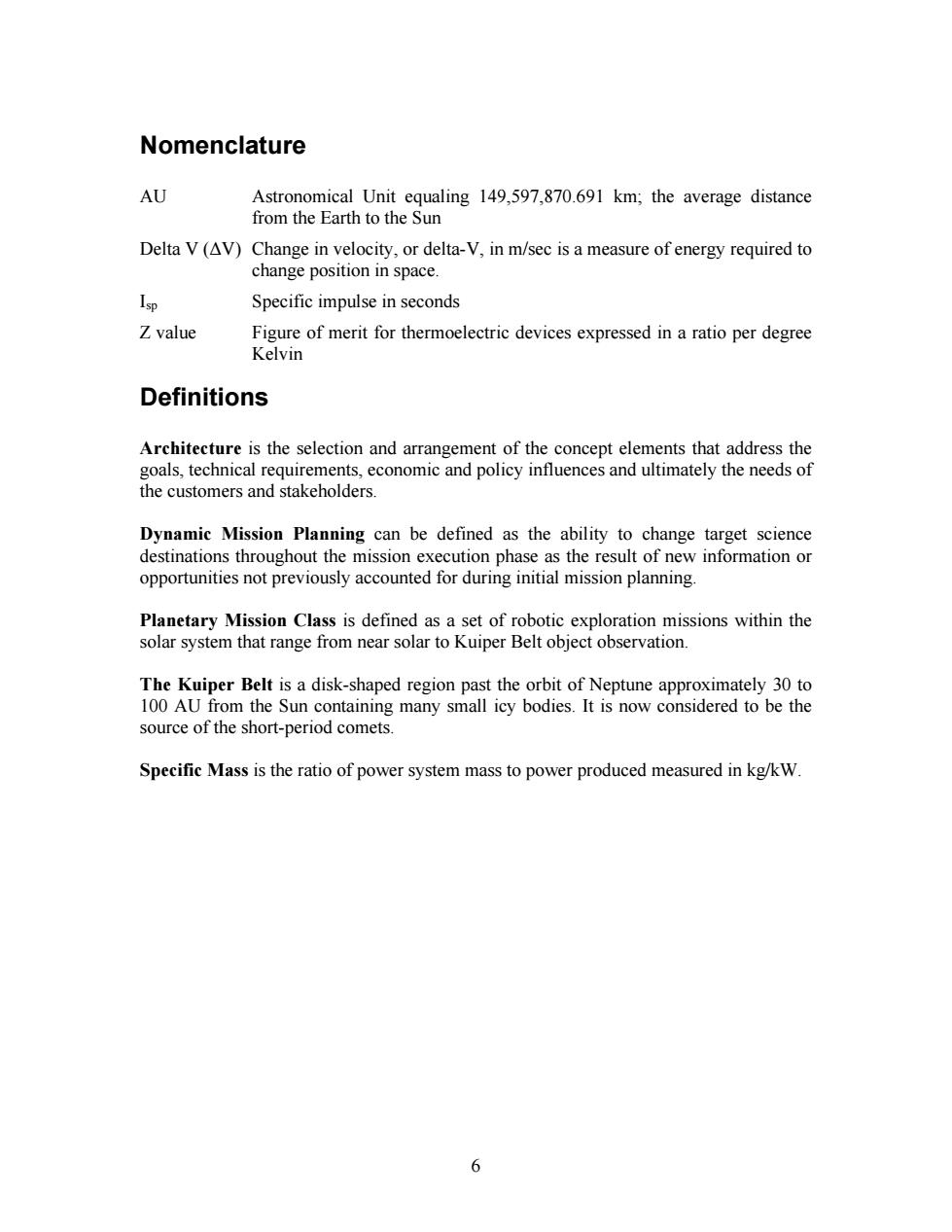
Nomenclature AU Astronomical Unit equaling 149,597,870.691 km;the average distance from the Earth to the Sun Delta V(AV)Change in velocity,or delta-V,in m/sec is a measure of energy required to change position in space. Isp Specific impulse in seconds Z value Figure of merit for thermoelectric devices expressed in a ratio per degree Kelvin Definitions Architecture is the selection and arrangement of the concept elements that address the goals,technical requirements,economic and policy influences and ultimately the needs of the customers and stakeholders. Dynamic Mission Planning can be defined as the ability to change target science destinations throughout the mission execution phase as the result of new information or opportunities not previously accounted for during initial mission planning Planetary Mission Class is defined as a set of robotic exploration missions within the solar system that range from near solar to Kuiper Belt object observation. The Kuiper Belt is a disk-shaped region past the orbit of Neptune approximately 30 to 100 AU from the Sun containing many small icy bodies.It is now considered to be the source of the short-period comets. Specific Mass is the ratio of power system mass to power produced measured in kg/kW. b
Nomenclature AU Astronomical Unit equaling 149,597,870.691 km; the average distance from the Earth to the Sun Delta V (∆V) Change in velocity, or delta-V, in m/sec is a measure of energy required to change position in space. Isp Specific impulse in seconds Z value Figure of merit for thermoelectric devices expressed in a ratio per degree Kelvin Definitions Architecture is the selection and arrangement of the concept elements that address the goals, technical requirements, economic and policy influences and ultimately the needs of the customers and stakeholders. Dynamic Mission Planning can be defined as the ability to change target science destinations throughout the mission execution phase as the result of new information or opportunities not previously accounted for during initial mission planning. Planetary Mission Class is defined as a set of robotic exploration missions within the solar system that range from near solar to Kuiper Belt object observation. The Kuiper Belt is a disk-shaped region past the orbit of Neptune approximately 30 to 100 AU from the Sun containing many small icy bodies. It is now considered to be the source of the short-period comets. Specific Mass is the ratio of power system mass to power produced measured in kg/kW. 6